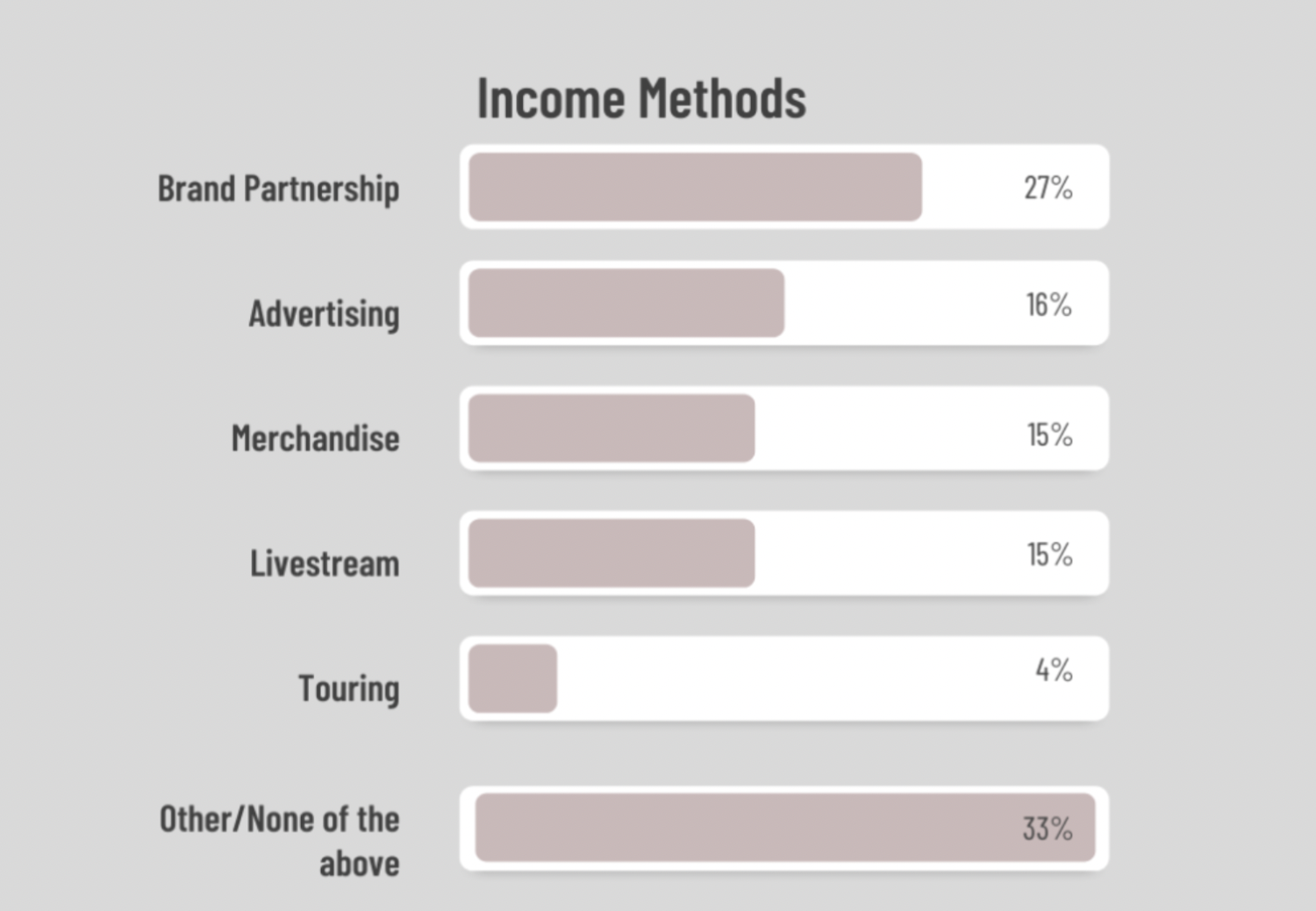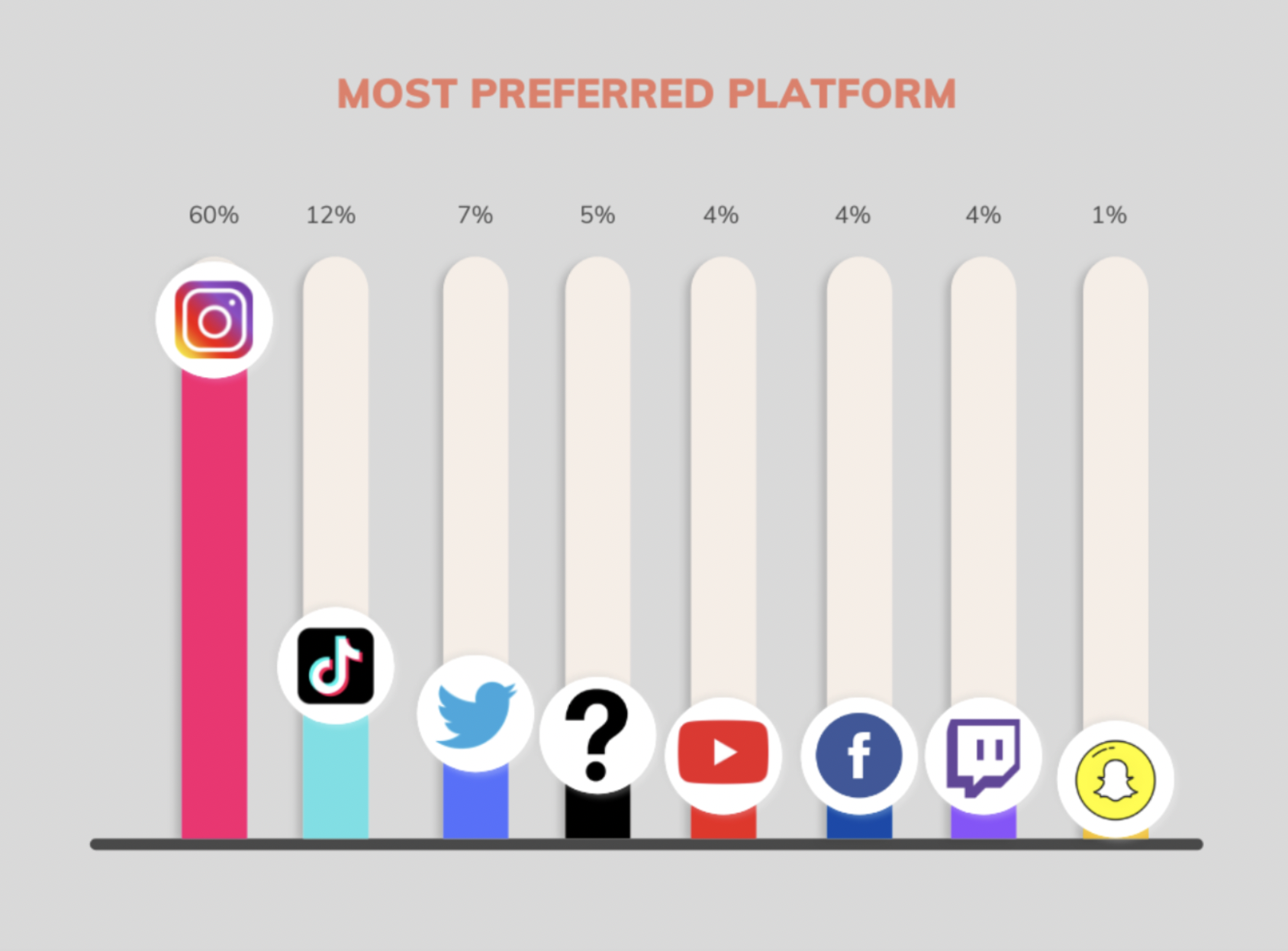Written by Caleb Chandler, Sara Fleischer, Hanqing Jin, Ariel Miller, and Ashley Tsai
Introduction
This article focuses on how content creators (an individual or group that creates and distributes digital content to an audience) are forging their paths as entrepreneurs and media companies. What is each creator’s journey like? How do content creators grow to become media companies? What services does the creator economy need as they grow bigger? From these questions, our group makes predictions about the future of the creator economy and recommendations for how creators can thrive within the landscape.
The Creator Economy
Filled with platforms that allow content creators to consume, create, and share content, the creator economy serves as a space for advertisers to benefit from an online marketing tactic known as influencer marketing (Geyser, 2022, para. 1). The total value of the creator economy is estimated to be over 100 billion dollars (CB Insights, 2021, para. 4). At the end of 2021, YouTube delivered $28.8 billion in advertising revenue (Werpin, The Hollywood Reporter, 2022, para. 1). The valuation of the creator economy is no surprise, as advertisers are always looking for more innovative and effective marketing tactics to reach consumers. Social media platforms like YouTube and TikTok profit handsomely from content creators because of increased advertising spending.
The Covid-19 pandemic made some consumers distrust big brands, and many companies had to find more authentic ways to market to upcoming generations. The resulting influencer marketing model will forever change how consumers buy and use the world's products. Everyone who consumes media, and specifically media professionals in the entertainment industry, should care about the creator economy as the formats in which creators are making content (TikTok, Reels, YouTube) affect audience's viewing habits, media consumption, and consumer spending, which ultimately impacts the entertainment landscape and the world.
Research
Unpacking how content creators grow to become media companies (individuals or groups that create and distribute digital content to an online audience) in and of themselves is a looming question for content creators and the larger marketing field. Critical to understanding that growth is dissecting what creators need to grow.
To complete this research, a survey was distributed. The purpose of the survey was to learn about individual creators' social media metrics and about these creators' strategies for monetizing their content. The survey provided further insight into the masses of the Creator Economy by examining trends and popular methods preferred by a large group. The survey received 153 responses across a four-month timeline.
In addition, interviews with six business professionals, both creators, and managers, who work within the 'Creator Economy' provided a comprehensive understanding of how individual creators work. Compared to the survey, where creators were asked broad questions, the interviews were constructed with complex and specific questions to obtain an in-depth look into content creators' strategies. A highlighted industry interview with digital leader Jake Webb provided great insight into the importance of rights management and ownership regarding a content creator's overall success in becoming a media company.
Survey results
Brand sponsorships was the most popular option for how creators make money, with 26% of participants saying it's a strategy they've used.
Figure 1 (Via authors):Comparing what creators are struggling with, and what services they want from an agency
When it comes to how creators choose deals, 28% said what the brand stands for matters. This was the highest percentage, with lucrative deals making up 21%. Instagram was the most popular social media platform, with 60% of survey respondents choosing it.
Figure 2 (via authors): A breakdown of the methods of how creators have monetized on their social media platforms.
For creators with the following size 100K - 1M, platform preference was more spread out: 16% Instagram, 16% Snapchat, and 33% TikTok.
Figure 3 (Via authors): The most popular platforms according to survey respondents.
When looking at full-time creators versus part-time, 46% said they want to be full-time, while 44% said it was not their main focus. Of the 46%, all of them had a following of at least one thousand followers; the majority of people with 1K - 100K followers want to be full time, while the majority of respondents who have under 1000 followers do not want to be full-time creators. When segmented based on the following sizes, 50% of those with 100K - 1M followers don't want to be full-time content creators, and 30% of the same group said they wanted to be full-time creators; 16% of people within this category are already considered full time.
Figures 4 & 5 (Via authors): How many survey respondents are considered full or part time creators, the percentage of respondents is on the y-axis. Figure 5 shows how many followers the respondents had on their largest platform.
Findings
Finding 1
There appears to be a power dynamic between content creators and the platforms they use.
Between algorithms and access to user support, creators must carefully navigate their relationships with platforms to build a following and successfully monetize their content. For example, if a creator encounters an issue on TikTok, it can be very difficult to get in touch with someone at TikTok for assistance. Having a lot of influence helps, but even more so, having a manager representing the creator in dealings with TikTok makes a difference (Interviewee 2, personal communication, February 3, 2022). Managers can play a key role in not only administrative needs and representation but also in funneling key monetization tactics such as brand deals and partnerships. Brand partnerships are especially important because they provide another revenue source (Interviewee 1, personal communication, December 22, 2021; A. Nolan, personal communication, February 3, 2022).
Finding 2
Each platform has a different monetization policy, so content creators must navigate the differences as they build their followings.
Many have found that YouTube has one of the better policies because it pays out more consistently (Interviewee 3, personal communication, January 11, 2022). However, some brands now only make deals for short-form content to easily repurpose the material, which does not lend itself as well to YouTube (Interviewee 4, personal communication, December 17, 2021). Because YouTube’s platform can house longer-form content, it is easy to generate ad revenue from advertisement placements. Once content creators are well-established, there is more opportunity to generate the ad revenue that enables them to receive more money with YouTube.
Finding 3
There is a big distinction between the different platforms, and although content can be repurposed, it takes a lot of additional work.
When putting YouTube content onto short-form content platforms, creators need to take the time to review the content, find the most engaging snippets, and change the original horizontal video to a vertical one. Kelsey Ryan told us that she had tried to repurpose her YouTube content on TikTok, but found that she was spreading herself too thin (Interviewee 3, personal communication, January 11, 2022).
Finding 4
What service creators need most from managers.
The most common areas that creators struggle with are negotiating brand deals, time management, managing fan engagement (such as messages and comments), and consistent scheduling (See Figure 1). One interviewee told us that it can take two to three hours to create an individual Instagram Reel, so time management and scheduling are important skills for creators to have access to (Interviewee 1, personal communication, December 22, 2021). Another survey respondent said they would like a “Release Manager” to help them decide what and when to post and what captions and hashtags to use so that they can focus on the actual creation. Another source also noted that, although she already uses several services and platforms, she wishes some were more people-focused than numbers-focused.
Predictions
With short-form content being a new entry point into the content creation world, we will continue to see a big push and demand. Existing content creators can easily branch out to short-form content as they re-purpose their old assets.
As the industry grows, creators can expect to see many service providers showing up in the industry to help creators in various areas, including but not limited to management, marketing, production support, and partnership support. The service providers will continue to establish niche areas that creators can take advantage of. It is also crucial that creators are aware of their own intellectual property and rights management. We expect to see an increase in rights management service providers in the industry.
We also expect to see platforms develop more creator-friendly monetization policies like creator funds. Creators are sensitive to monetization opportunities as they grow. For a platform to keep the creators, it will need to diversify metrics to provide various opportunities for creators to monetize. Through research and interviews, this research found that content creators utilize different platforms to grow. For content creators navigating the different ways to utilize these platforms, creators run into the challenge of autonomy and ownership. This challenge leads to the desire for content creators to have a more direct-to-fans model, as platforms such as Patreon and OnlyFans provide. These platforms that allow content creators to convert their loyal fanbases into consistent, paying consumers of content will become popular. We expect popular platforms like Instagram and TikTok to develop more features to enable direct-to-fan communication and monetization.
Recommendations
Based on our analysis, we designed a Creator Roadmap for future creators to find their ways to success; a guideline mapping out beneficial suggestions. Our Creator Roadmap recommendations are as follows:
First, use TikTok, as it is the easiest platform for a creator to go viral and gain a large initial following because of the nature of their algorithm.
Next, invite TikTok followers to a preferred platform on which it is easy to reach followers (like Instagram) to continue engagement, grow the brand, and be a part of two creator funds. After each of these steps, a creator can identify their loyal followers, those who follow the creator on multiple platforms.
Next, creators should continue to grow their brand and diversify revenue streams by creating or repurposing content on monetization-friendly platforms like YouTube. The content creator will now be a part of the three most significant platform creator funds.
The final and hardest recommendation is to bring followers off of social media to a subscription-based platform like a Patreon or OnlyFans account. It is important to note that this roadmap may not be suited for every person's content and is not fit for a subscription-type platform. But, the roadmap can work for the majority of people who want to start creating short-form content.
Conclusion
Accelerated by the pandemic and accessibility to smartphones, the creator economy has seen rapid growth. In addition to an influx of nomad workers and individuals wanting to control their work lives, creating content is a growing opportunity to make a living. Platforms such as TikTok have become a social hub for creators of all backgrounds to share niche content and find their audience. With this prime opportunity on social media platforms, the business of the creator economy has become more demanding from individual creators who want to take full control of their IP. Creators are finding it harder to manage everything from fan engagement to consistent posting and managing their social media platforms. Also, only a small percentage of creators see a paycheck equivalent to a livable wage. Hence, a creator needs to be able to devote time to growing their social media pages if they want to become a successful influencer.
-
Geyser, W. (2022, March 2). What is influencer marketing? - the ultimate guide for 2022. Influencer Marketing Hub. Retrieved March 3, 2022, from https://influencermarketinghub.com/influencer-marketing/
CB Insights. (2021, June 23). The creator economy explained: How companies are transforming the self-monetization boom. CB Insights Research. Retrieved November 4, 2021, from https://www.cbinsights.com/research/report/what-is-the-creator-economy/#definition





